Hummingbirds are the best flyers out there,” said Bret Tobalske, a biology professor and director of the University of Montana’s Flight Lab, US. “They are extreme in their physiology and flight performance. They are incredibly maneuverable. They are capable of hovering indefinitely” — an adaptation driven by a love of nectar.
As crew-less vehicles have taken over the skies in conflicts, hummingbirds have become the subject of new research. The Flight Lab — accustomed to looking at the ecology, evolution and biomechanics of bird flight — is part of an effort funded largely by US defence dollars to build a better robotic hummingbird. Mimicking these birds — a phenomenon known as bio-inspired technology — is the holy grail for the makers of flying robots.
“A real hummingbird can literally fly circles around robotic hummingbirds,” Tobalske said. “They can fly circles around real birds too.”
There have been hummingbird robots built — most notably the Nano Hummingbird, built by Aero-Vironment, a private company, with funding from the Defense Advanced Research Projects Agency — but they have myriad limitations. “None of these robots can fly fast forward,” said David Letink, a professor of biomimetics at Groningen University in the Netherlands who has studied and built flying robots for decades. “That can only be performed by bigger robots.”
Aircraft design has long been informed by avian flight. And numerous flight labs study several types of creatures — hawk moths, dragonflies, bats and hummingbirds — to examine the secrets of their flying skills. Much of the work is funded by defence agencies, with the aim of using the knowledge to design better aircraft.
The work at Flight Lab in Montana is funded by the Office of Naval Research, part of the US Defense Department.
A robot based on a hummingbird might not be likely to carry weapons but instead could be deployed to scout streets ahead of troops, spy on troop movements or be dispatched to search for wounded soldiers in places where humans can’t go, such as inside a collapsed building or a tunnel.
The wings of many hummers beat about 50 times a second, the most of any bird; by contrast, a pigeon’s wings beat nine times a second. Hummingbird hearts, the size of a pea, beat 1,200 times a minute when the bird is active. Human hearts beat 60 to 100 times a minute.
The birds are also deceptively strong. “Hummingbirds have more power output gram for gram than any other vertebrate,” Tobalske said.
The researchers here are primarily focused on the calliope hummingbird, which weighs less than two paper clips. Yet every fall, the bird travels a risky migratory path through wind, rain and snow from the Pacific Northwest to southern Mexico.
Much about hummingbird ecology is a mystery, largely because the birds are much too small for tracking devices. But they are very transient, Tobalske said. “They spend three months travelling south and three months travelling north again.”
Researchers also study rufous and black-chinned hummingbirds.
There are nearly 370 species of hummingbirds in the world, found only in North and South America. When Spanish explorers first travelled to South America, they were delighted by the brightly coloured, iridescent, hovering birds, which they called joya valadoras (flying jewels).
Despite the time and funding that has gone into trying to grasp the complex dynamics of hummer flight, a thorough understanding remains elusive.
A decade ago, researchers took a mobile lab into the Peruvian Amazon, Costa Rica and the Ecuadorian Andes. They studied 200 hummingbirds and tracked 3,30,000 manoeuvers in their natural habitat.
Paolo Segre, an assistant professor at the University of Wisconsin, Green Bay, US, and Roslyn Dakin, associate professor at Carleton University, Canada, divided the manoeuvers into three categories: pitching up and down; accelerating and braking; and complex, sharp turns.
One of their discoveries, counterintuitively, was that larger hummingbirds can manoeuvre more easily than smaller birds because they have more muscle mass and a larger wing in proportion to their bodies.
One aspect of the study of how the birds fly involves measuring the air velocity, pressure and viscosity that flow around the wings and support flight. Equations that explain this phenomenon are so complex that it takes a supercomputer weeks to devise a model of the aerodynamic forces.
The birds’ bodies, especially the wings and tail, morph repeatedly and undergo numerous changes as they fly.
That complexity is difficult to replicate. For robot designers, “the biggest challenge is to change the shape of the wing and the tail like a bird does”, Letink said.
“This has not really been cracked by engineers,” he said. “Making the wing shape change like you see in a bird, not only the sweeping motion, but the twisting motion and the folding, to do all of that is super hard for an engineer.”
Another major obstacle to replicating a hummingbird’s flight lies in the bird’s singular adaptation to wind, or gust tolerance.
“We like to fly our drones on calm days because they don’t like wind,” said Moble Benedict, who builds robots at Texas A&M University, US, that are based on the kind of research the Tobalske lab does. “It’s the exact opposite with birds. You see more in the sky on windy days. They are not trying to fight winds, they are flying with the wind.”
This is especially important because as the climate warms, turbulence is increasing.
Developing a hummer robot that could fly like the real thing is possible but still years away, experts say.
NYTNS










